土壤微生物概述:
- 微生物多樣性: 土壤樣本含有大量微生物, 其中大部分不能直接培養用於研究.
- DNA 萃取的重要性: 萃取 DNA 是研究土壤樣本中這些微生物的重要方法.
DNA萃取方法:
- 直接法:
- 過程: 涉及將土壤樣本直接放入裂解溶液中,並使用機械或化學方法打破細胞壁, 從而將微生物 DNA 釋放到溶液中.
- 技巧: 包括有效裂解的破壁方法; 例如, 週氏方法.
- 優點: 最大化獲得整個基因組內容的可能性 (宏基因組) 土壤微生物的.
- 間接法:
- 過程: 首先將土壤懸浮在緩衝溶液中 (例如, 緩衝液PBS) 在 DNA 提取之前從土壤顆粒中分離微生物.
- 優點: 減少腐植酸和重金屬鹽等抑制劑對 DNA 萃取過程的影響.
- 缺點: 可能導致分離過程中失去許多微生物, 並且通常無法恢復完整的宏基因組.
挑戰和考慮因素:
- 直接法的挑戰: 雖然它增加了獲得完整基因組的機會, 此方法可能會因土壤中腐植質和重金屬等抑制劑的存在而受到影響.
- 間接方法的限制: 使用這種方法的研究人員較少,因為它可能會失去微生物多樣性和基因組提取的完整性.
- 腐植酸污染.土壤, 尤其是在森林和草原, 富含腐植酸. 腐植酸是一系列有機分子, 其中一些與核酸分子非常相似,在純化過程中難以去除. 微量腐植酸污染可能會導致下游應用,例如 聚合酶鍊式反應 和酵素消化失敗.
- 裂解法.土壤樣本含有多種微生物, 例如細菌和真菌. 革蘭氏陽性細菌和真菌都含有非常厚的細菌壁, 有效分解這些微生物的細胞壁對於提取高產宏基因組DNA至關重要. 由於土壤樣本的複雜性, 使用酵素法是不可行的 (例如溶菌酶, 破壁酶, 蝸牛酵素) 或液態氮研磨, 因為土壤中含有各種金屬離子或抑制因子,會使消化酵素失去活性, 或土壤中存在沙粒使液態氮研磨變得困難.
- DNA產量難以控制.由於肥力作用,土壤樣本中微生物的數量和種類會發生顯著變化, 自卑, 高水分含量, 乾燥, 或採樣深度. 在小範圍的土壤樣本中, DNA含量往往相差數千倍. 另外, 土壤中的某些化學成分, 例如重金屬鹽和黏土物質, 可能會導致 DNA 產量下降.
Magen HiPure 土壤 DNA 試劑盒的特點:
-
最佳化:
- 現在, 被認為是土壤 DNA 萃取最優化的試劑盒, 提供高效可靠的結果.
-
提取方法:
- 採用玻璃珠研磨和熱衝擊化學破壁方法結合.
- 與點渦流儀器相容, 無需專門的珠磨設備.
- 適用於各種實驗室環境.
-
腐植酸去除:
- 包含吸收劑解決方案, Magen 開發的專有腐植酸吸附劑.
- 高效去除土壤樣本中的各種腐植酸污染物, 提高 DNA 純度.
-
可溶性抑制劑的去除:
- 以無醇矽膠柱純化方法去除土壤樣本中的可溶性金屬鹽類和其他抑制因子.
-
多功能應用:
- 成功從各種土壤類型中提取 DNA, 包括森林土壤, 紅樹林土壤, 草原, 農地, 海底泥, 污泥, 礦區土壤, 和更多.
- 支持快速可靠地分離高品質基因組 DNA.
-
處理能力和時間:
- 能夠處理多達 500 土壤樣本毫克數 60 分分鐘, 促進高通量工作流程.
-
PCR相容性:
- 純化的 DNA 適用於 PCR, 限制性消化, 和下一代定序應用.
-
效率和永續性:
- 利用 HiPure 基質的可逆核酸結合特性 旋轉柱 消除腐植酸等 PCR 抑制化合物的技術.
- 無需有機提取,減少塑膠浪費和操作時間, 實現多個樣本的平行處理.
規格
| 特徵 | 規格 |
| 主要功能 | 從 200-500 毫剋土壤樣本分離 DNA |
| 應用領域 | 聚合酶鍊式反應, Southern印跡和酵素消化, ETC. |
| 純化方法 | 迷你旋轉柱 |
| 淨化技術 | 二氧化矽技術 |
| 工藝方法 | 手動的 (離心或真空) |
| 樣品類型 | 土壤 |
| 樣品量 | 200-500毫克 |
| 洗脫體積 | ≥30μl |
| 每次運行時間 | ≤60分鐘 |
| 每根柱的載液量 | 800微升 |
| 柱結合率 | 100微克 |
土壤DNA萃取過程:
- 均質化和裂解:
- 將土壤樣本均質化以確保均勻性.
- 然後在含有去垢劑的特殊配製緩衝液中進行處理,以有效裂解細菌, 酵母菌, 和真菌樣本.
- 污染物去除:
- 我們專有的吸收劑解決方案可有效去除腐植酸, 蛋白質, 多醣, 以及裂解樣本中的其他污染物.
- 裝訂及洗滌:
- 裂解的樣品經過結合條件的調整並應用於 DNA Mini Column.
- 兩個快速清洗步驟可有效去除微量污染物, 確保純度.
- 純化 DNA 的洗脫:
- 純 DNA 在低離子強度緩衝液中從管柱中洗脫.
- 所得的純化DNA品質高,無需進一步純化,可直接用於下游應用.
優點
- 快速地 – 可以提取多個樣本 40 分分鐘 (消化後)
- 高純度 – 純化的DNA可直接用於各種下游應用
- 重複性好 – 二氧化矽技術每次都能獲得理想的結果
- 高回收率 – DNA 可以在 PG 水平上回收
套件內容
| 內容 | D314202 | D314203 |
| 淨化時間 | 50 準備工作 | 250 準備工作 |
| Hipure DNA 迷你柱 II | 50 | 250 |
| 2毫升收集管 | 50 | 250 |
| 2毫升珠管 | 50 | 250 |
| 緩衝液 | 60 毫升 | 250 毫升 |
| 緩衝 安全資料表 | 5 毫升 | 20 毫升 |
| 緩衝液PS | 10 毫升 | 50 毫升 |
| 吸收劑溶液 | 10 毫升 | 50 毫升 |
| 緩衝液全球升溫潛勢值 | 40 毫升 | 220 毫升 |
| 緩衝器DW1 | 30 毫升 | 150 毫升 |
| 緩衝器 GW2* | 20 毫升 | 2 X 50 毫升 |
| 緩衝AE | 15 毫升 | 30 毫升 |
儲存說明:
- 吸收劑溶液:
- 抵達時, 儲存於2-8°C.
- 短期儲存 (取決於 24 週) 在室溫下 (15-25℃) 不影響性能.
- 其餘套件組件:
- 在室溫下儲存乾燥的組件 (15-25℃).
- 至少穩定 18 在這些條件下幾個月.
實驗數據
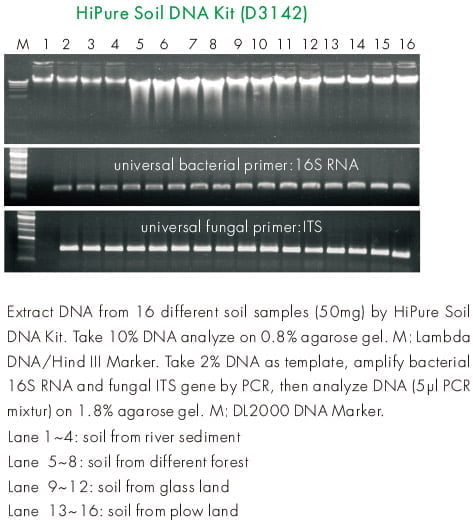

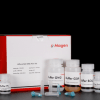
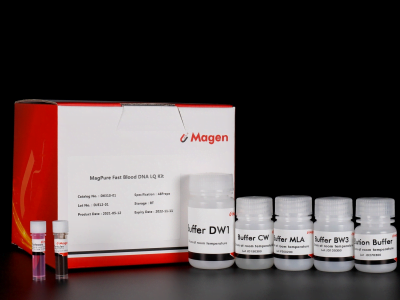
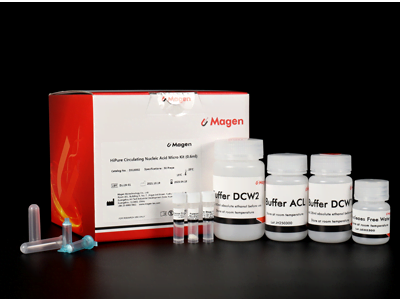
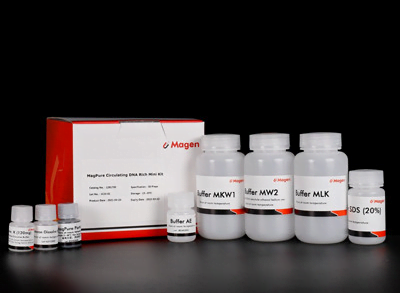
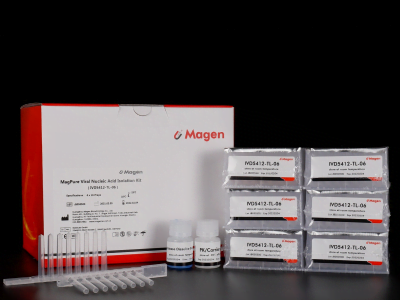
評論
還沒有評論.